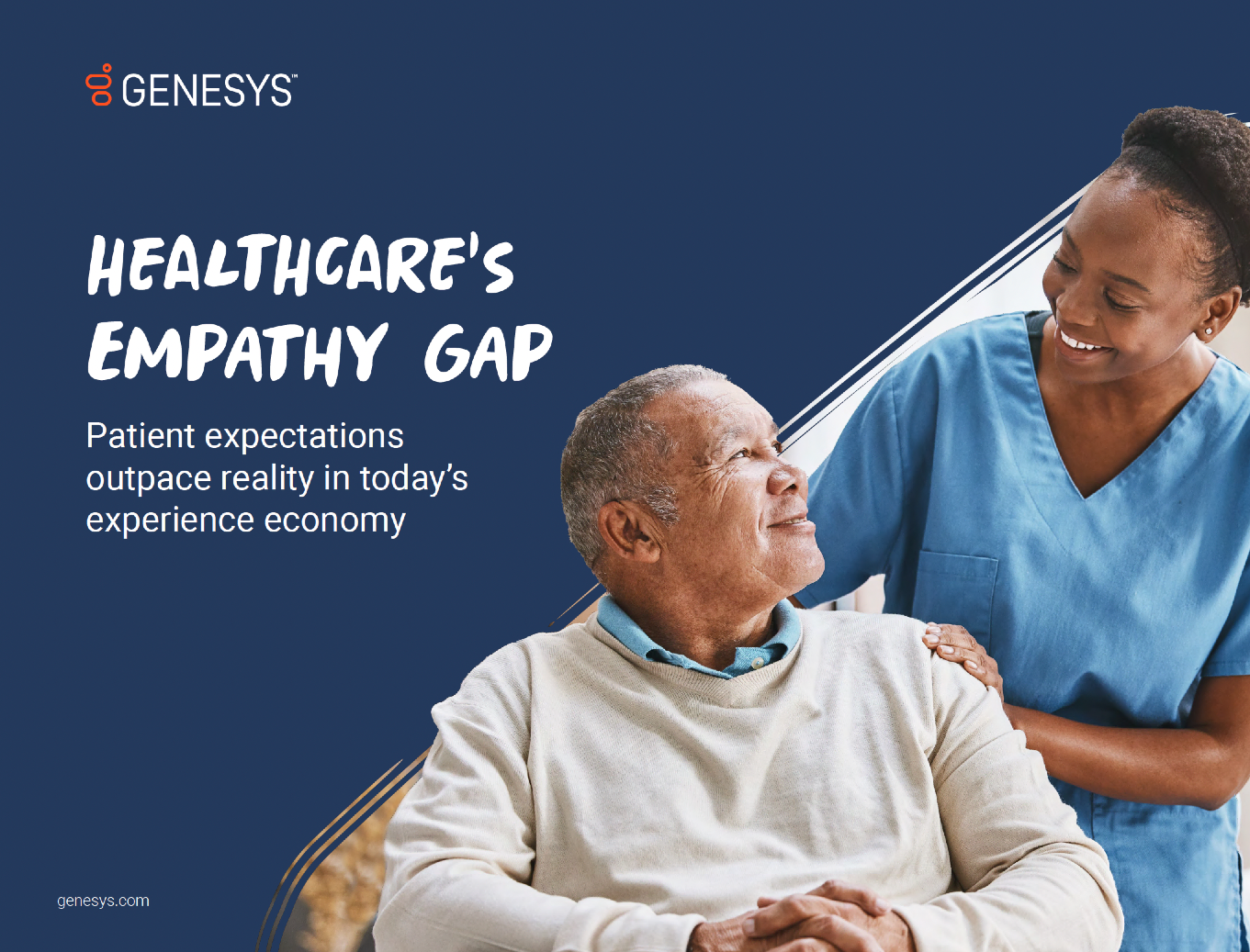Your Genesys Blog Subscription has been confirmed!
Please add genesys@email.genesys.com to your safe sender list to ensure you receive the weekly blog notifications.
Subscribe to our free newsletter and get blog updates in your inbox
Don't Show This Again.

Navigating healthcare systems can be complex. And when a person’s health is on the line, unnecessary delays and complications experienced accessing care can create additional stress. And it’s not just patients who suffer when the patient experience is frustrating and difficult. Healthcare provider organizations risk losing patients — and payors risk losing membership. Among those with the freedom to choose a different health insurer, 34% were dissatisfied enough with their current insurer to say they were likely to switch, according to the Forrester 2021 “US Health Insurers Customer Experience Index” as cited by Fierce Healthcare.
Often, that dissatisfaction rests on one overarching complaint — getting care is too difficult. Beneath that complaint is a litany of frustrations: It takes multiple calls to schedule an appointment with the right doctor; it’s confusing to know where to park or how to find the clinic upon arriving at the health complex; an unexpected bill arrives and it’s unclear why out-of-pocket costs are so high for the procedure.
In each of these frustrations, the difficulty of navigating the healthcare system is the driving factor. In other words, it takes too much patient effort to get the care they need and expect.
But what exactly is patient effort? And how do you measure it and its impact on patient satisfaction? Providers and payors already have a treasure trove of patient and member interaction data to help them analyze the flow of the patient journey when identifying points where patients expend too much effort.
With that data in hand, you can set priorities to streamline the patient experience across the continuum of care by reducing effort at the points of greatest impact.

Download the report for insights, opportunities and the path forward for healthcare providers wanting to empower patients with seamless journeys.
When examining interaction data, you’ll need to go beyond production metrics such as call volume and average handle time. Those measurements are useful for operational management, but they don’t offer insights into how much effort patients expend throughout their care journey. To identify opportunities to reduce their efforts, consider repeat interactions, wait times and transfer rates. Disaggregating the data by issue type and provider will offer even clearer insights.
It’s important to generate normalized index values for your metrics to avoid misinterpreting trends. Raw data can be misleading; a surge in interactions could indicate a new issue that increases effort — or it could be the result of acquiring new patients or members. Normalized index values put data variability into context by converting total counts into rates per member or patient population.
Over time, theses normalized values provide a solid foundation for spotting trends and evaluating the impact of process improvements. For example, a billing question related to a specific procedure might typically be resolved with a single interaction — with a small number of cases requiring two or more conversations. Over your entire patient population, that might result in a normalized index of 1.15 interactions, which provides a baseline to assess performance against. A future increase in the index could indicate a new problem to address, while a decrease might suggest your process improvements are having a positive impact.
The right data can tell you what’s happening — but it can’t tell you why. To answer that question, you’ll need to weigh qualitative information alongside your quantitative metrics. It requires some detective work, but artificial intelligence (AI) can help you gather the qualitative information you need more efficiently.
Start by collecting recordings and transcripts from key interactions related to the metric and interaction type you’re investigating. Speech and text analytics driven by AI can generate transcripts annotated with sentiment analysis. And, with AI-powered topic spotting, you can quickly identify interactions related to a specific issue of interest.
Next, you’ll need to mobilize your team. Their expertise and professional judgment will be instrumental in diagnosing the underlying problems and devising effective solutions. Ask your quality and escalation teams to read the transcripts and listen to the recordings to categorize the interactions and agree on a common set of descriptors. You could base categories on location, patient/membership segment, type of service or phase of the patient journey. Then, have the team create and calibrate a scoring system to evaluate the interaction.
Finally, assemble a larger cross-functional team that includes the roles responsible for the step in the patient journey that you’re investigating. An engaged and empowered community offers perspective and establishes connections between leaders and care team members to shape an organization’s strategy to deliver better patient experiences. For example, if you’re reviewing interactions related to appointment scheduling, be sure to include members of the scheduling team. Their specific experience will inform their judgment of the interactions and enable them to spot problems and identify solutions. Have this broader team score and discuss the interactions and suggest changes that will reduce effort and streamline the patient experience.
Once you pinpoint the process and performance issues — and have a list of suggested solutions — you can prioritize the interventions. Your interaction data offers useful guidance for determining your strategy and designing a roadmap for improvement.
To maximize your impact on both patient satisfaction and operational efficiency, you’ll want to focus on experiences that are high in effort and affect the greatest number of patients or members. Improving self-service options, personalizing interactions with chatbots and enhancing patient portals are all ways to reduce patient effort. If patients have trouble navigating the health complex to find the right clinic, a pre-appointment email or text that includes a map and directions can prevent patient frustration and reduce the impact of late arrivals on the clinic’s operations. Likewise, proactive communications that explain changes in a member’s coverage as they enroll in a new plan can help avoid confusion and frustration if, for example, out-of-pocket expenses have changed for a procedure or prescription.
Data-driven insights can also improve live interactions with service representatives and help representatives anticipate additional questions or concerns a member might have later. For example, when a member calls for help finding an in-network specialist, the representative should also provide guidance on getting pre-approval for a procedure that will likely be scheduled — and advance notice of expected out-of-pocket costs. By anticipating these future needs and meeting them proactively, the representative can prevent repeat calls.
The goal is to know your patients or members, anticipate their needs and proactively offer the right service at the right time. An omnichannel approach designed to provide a consistent, seamless and connected experience enables you to improve patient satisfaction and outcomes, support care teams and reduce operating costs.
A data-driven approach that enlists a broad cross-functional team is an effective strategy for targeting reduction in patient effort to improve the patient journey. It also has other important long-term benefits. By sharing data internally and discussing pain points across the organization, you can build awareness of operational challenges and encourage buy-in for solutions. It’s easy for administrators and medical personnel who lack visibility into service issues to unwittingly implement processes that create frustrations for patients and members. But when they listen to patients describe challenging encounters firsthand, the experience can be enlightening. Often, it yields powerful insights not just for improving the patient journey but also for understanding and enhancing the daily routines and realities of employees who handle those interactions.
Without a shared organizational culture of data-driven continuous improvement, the process changes that reduce patient and member effort can be short-lived. Sharing information and insights is a critical step in creating and maintaining a culture that will support long-term patient experience transformation. And it all starts with data.
Read the full report “Healthcare’s empathy gap” online today.
Subscribe to our free newsletter and get blog updates in your inbox.
Related capabilities: